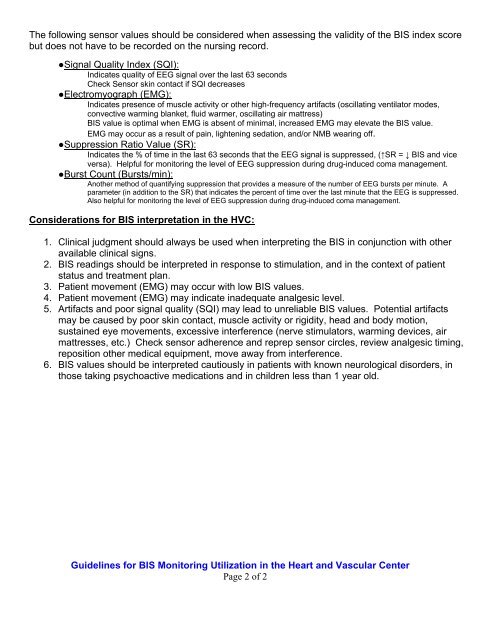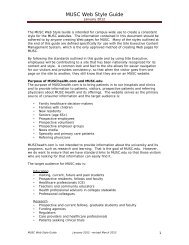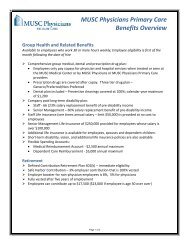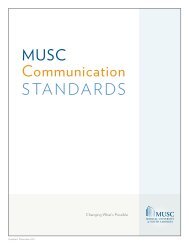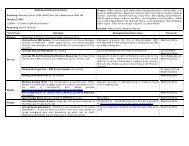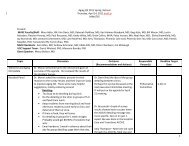BIS Monitoring Guideline - Medical Center Intranet
BIS Monitoring Guideline - Medical Center Intranet
BIS Monitoring Guideline - Medical Center Intranet
You also want an ePaper? Increase the reach of your titles
YUMPU automatically turns print PDFs into web optimized ePapers that Google loves.
The following sensor values should be considered when assessing the validity of the <strong>BIS</strong> index score<br />
but does not have to be recorded on the nursing record.<br />
●Signal Quality Index (SQI):<br />
Indicates quality of EEG signal over the last 63 seconds<br />
Check Sensor skin contact if SQI decreases<br />
●Electromyograph (EMG):<br />
Indicates presence of muscle activity or other high-frequency artifacts (oscillating ventilator modes,<br />
convective warming blanket, fluid warmer, oscillating air mattress)<br />
<strong>BIS</strong> value is optimal when EMG is absent of minimal, increased EMG may elevate the <strong>BIS</strong> value.<br />
EMG may occur as a result of pain, lightening sedation, and/or NMB wearing off.<br />
●Suppression Ratio Value (SR):<br />
Indicates the % of time in the last 63 seconds that the EEG signal is suppressed, (↑SR = ↓ <strong>BIS</strong> and vice<br />
versa). Helpful for monitoring the level of EEG suppression during drug-induced coma management.<br />
●Burst Count (Bursts/min):<br />
Another method of quantifying suppression that provides a measure of the number of EEG bursts per minute. A<br />
parameter (in addition to the SR) that indicates the percent of time over the last minute that the EEG is suppressed.<br />
Also helpful for monitoring the level of EEG suppression during drug-induced coma management.<br />
Considerations for <strong>BIS</strong> interpretation in the HVC:<br />
1. Clinical judgment should always be used when interpreting the <strong>BIS</strong> in conjunction with other<br />
available clinical signs.<br />
2. <strong>BIS</strong> readings should be interpreted in response to stimulation, and in the context of patient<br />
status and treatment plan.<br />
3. Patient movement (EMG) may occur with low <strong>BIS</strong> values.<br />
4. Patient movement (EMG) may indicate inadequate analgesic level.<br />
5. Artifacts and poor signal quality (SQI) may lead to unreliable <strong>BIS</strong> values. Potential artifacts<br />
may be caused by poor skin contact, muscle activity or rigidity, head and body motion,<br />
sustained eye movements, excessive interference (nerve stimulators, warming devices, air<br />
mattresses, etc.) Check sensor adherence and reprep sensor circles, review analgesic timing,<br />
reposition other medical equipment, move away from interference.<br />
6. <strong>BIS</strong> values should be interpreted cautiously in patients with known neurological disorders, in<br />
those taking psychoactive medications and in children less than 1 year old.<br />
<strong>Guideline</strong>s for <strong>BIS</strong> <strong>Monitoring</strong> Utilization in the Heart and Vascular <strong>Center</strong><br />
Page 2 of 2


